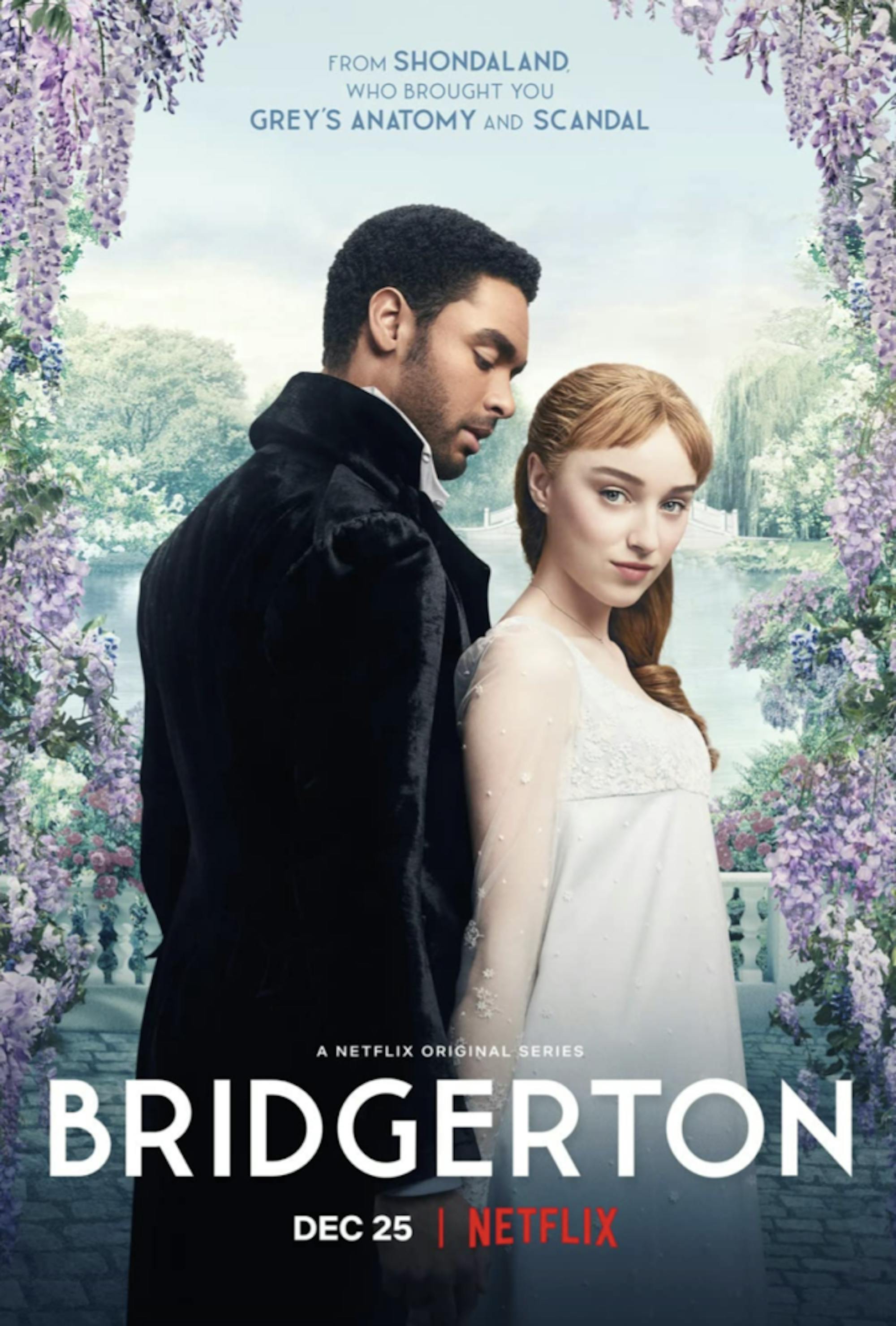At one point during winter break, you could not make it three videos down your TikTok "For You" page without seeing "#BRIDGERTON" or yet another try-on video of that one green Amazon corset. The latest endeavor to come out of Shondaland, Shonda Rhimes’ production company, "Bridgerton" (2020–) is a fatuous, yet exceedingly decadent Regency-era series that chronicles the upper crust Bridgerton family as they navigate society and their rivalry with the neighboring (and far less prestigious) Featherington family, set against the backdrop of the impending social season. The show is based on Julia Quinn’s book series by the same name (2000–2013) and is partially narrated by the mysterious and omniscient Lady Whistledown who is voiced by none other than Julie Andrews.
“Bridgerton” is Jane Austen meets "Gossip Girl." The line, “Dear reader,” replaces “XOXO, Gossip Girl,” and passionate, unexpectedly explicit sex scenes replace the Victorian chastity of Austen’s stories, which left the sordid details of pleasure behind closed doors. Nearly every other Austen trope, however, is represented here, from debonair, blue-blooded bachelors to porcelain-faced, rosy-cheeked belles to opulent balls to — arguably most traditionally Austenian — a mid-story family blow-up where secrets that can only be described as less-than-becoming inevitably emerge.
The first 8-episode season of “Bridgerton” centers primarily on Daphne (Phoebe Dynevor), the eldest Bridgerton daughter who is most eager to marry, due in part to her sense of obligation to elevate her family’s status following the death of her father. After earning the endorsement of the queen (Golda Rosheuvel), who anointed her “the diamond of season,” Daphne finds herself the center of attention and the apple of the eye of every eligible bachelor in the "Ton."
The series really picks up when the dashing Simon Basset, Duke of Hastings (Regé-Jean Page), sweeps dramatically into town carrying a chip on his shoulder unwieldy enough to rival Lady Featherington’s hair. Brooding, tortured and charming, the duke fits neatly into one of the genre’s most common archetypes. Even more, Page brings a vulnerability and a charismatic intensity to the role that sets it apart from the other characters. His romance with Daphne is another case of a common romance trope with a bit of a twist. Their story is one of forbidden love. Forbidden not by society nor family but rather by the duke’s own vow to never marry nor sire an heir.
In fact, in true Rhimes form, it seems that the concept of taking stereotypes and pushing their boundaries just a little comprises the entire premise of “Bridgerton.” This particular genre often weaves together romance with conflict and virtuousness with debauchery and lust — all of which are almost exclusively straight and white, evoking an incorrectly homogenous image of the era that prevails in its consumers’ consciousness. “Bridgerton,” on the other hand, embodies the genre’s hallmarks of romance, lust, beauty and luxury, while rejecting the notion that these components must be straight and white.
With the exception of the all-white Bridgerton family, the Ton gentry is full of Black actors — including the duke, Lady Danbury (Adjoa Andoh), the Featheringtons’ cousin Marina (Ruby Barker) and the queen (Golda Rosheuvel) — who, in another work of the period, may have been relegated to background roles. Still, while “Bridgerton” certainly outdoes its genre counterparts as far as visibility is concerned, its substance never breaks the surface.
The show’s attempts at diversity feel half-baked at times. Beautiful, powerful Black characters are sprinkled into the series without acknowledging the fact that they are Black. Thus, the implication is the story takes place in a magical, post-racial colorblind orbit.
Marina’s storyline is the most unfortunate of “Bridgerton’s” racial failures. She takes an almost Cinderella-like role in the Featherington household. Marina is a clever and resilient woman of color with a captivating inner fire that affords her the potential for a brilliant character development arc.
Instead, the writers reduced her to a mere pawn in the Bridgerton vs. Featherington rivalry. Her friendship arc with Penelope Featherington (Nicola Coughlan) devolves to ultimately paint Marina as an interloper, seeking to entrap an innocent Colin Bridgerton (Luke Newton) and keep Penelope from the love of her life.
Rather than depicting her story as one of endurance or a determined working-class girl who triumphed over a discriminatory society, she is spun, much like the duke is, as cunning and manipulative, deceiving her white lover to serve her own interests. Equally unjust, she is given a perfunctory conclusion. She is clumsily dismissed from the show with little recognition of her impact on any of the other characters’ lives or the plot as a whole.
“Bridgerton’s” failures regarding race and class issues are particularly disappointing because it has all the other ingredients for a beautiful, romantic confection. The sets, costumes, music and casting are all masterfully done, with every satin-y dress, pristine garden and ornate staircase curated to inspire romantic dreams in the audience’s minds.
One can only hope the following seasons bring much-needed depth and nuance that can do justice to an otherwise gorgeous piece of work.






